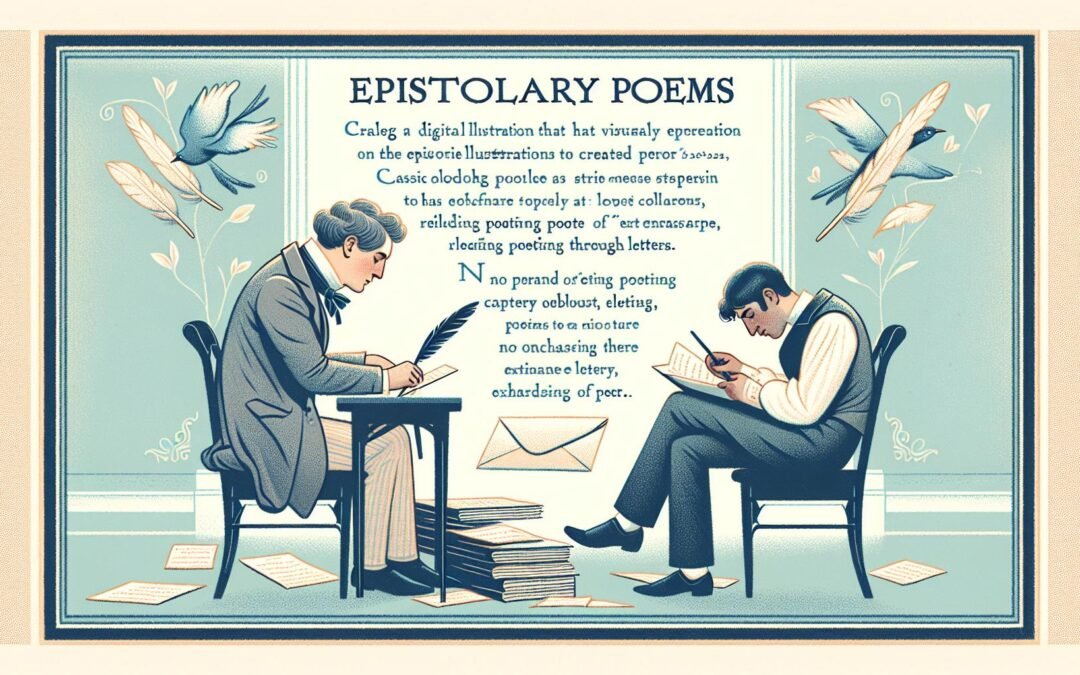In the beginning a poem travels toward another, bearing its heart within a sealed envelope. The epistolary poem inherits its form from the oldest impulses of communication, born of the Latin epistola—itself ushered forth from the Greek epistolē, a vessel for messages longing to transcend miles and time. Orality once cradled communal memory, the poem spoken aloud to a rapt circle. The letter, when lifted into verse, allowed the spirit to roam—broadcasting voices that longed for absent beloveds or distant confidants. Releasing utterance from embodied presence, these poetic letters wove intimate revelations, blending persuasion, seduction, and confession. Across the ancient Mediterranean, poets reached across silence; address became both anchor and invitation, the addressee a guiding star for narrative and emotion, kindling honest or involuntary truths.
Epistolary Poems: Meaning, Distinctions, and Origins
Standing at a crossroads of lyric and narrative, epistolary poems do not communicate with some vaporous audience. The sender’s words carry intent, direct as an arrow, toward a recipient—true or imagined. The conventional lyric dwells within the contours of self; the epistle manifests unrest by reaching outward, drawing the anxious spirit into exchange. What divides this form from a dramatic monologue? The monologue simulates overheard speech; the epistle pulses with intent—shaped to reach, shaped to be known or felt. It calls for sender and receiver, a circuit of utterance alive to the possibility of reply. This structure distinguishes the epistolary from fragments or odes (see more on types of love poetry), designing the poem as a vessel for exchange rather than self-enclosed meditation.
Etymology and Historical Resonance
Epistolary poems bear the scent of longing. Address begets intimacy, the writer’s voice amplifying vulnerability. The poet, once author and recipient of interiority, takes up the role of correspondent, sometimes baring wounds, sometimes shrouding meaning in suggestive riddles. A single word, sometimes a salutation, marks the boundary between presence and absence, between what is spoken and the silence that follows. This tension, vibrant at the threshold between dialogue and longing, threads through epistolary tradition from Sappho’s lyric calls to Ovid’s stirring monologues, resting gently in the palm of every modern adaptation.
Key Features: Address, Voice, Audience
Every act of address in these poems becomes transformative: words are given not to the anonymous ether, but to a you—singular, plural, sometimes a ghost. The lyric “I” puts on the garments of a messenger, blurring the ordinary line between candor and invention. Voice shimmers between open-hearted confession and subtle encryption, crafting declarations, appeals, blessings, or provocations of every timbre. The addressee may be near or impossibly distant, present in name only or hidden within longing; the poem stages the impossible meeting, binding speaker and recipient even as it exposes what cannot be breached. Contemplating this delicate dance is essential within the romantic poems to make her feel special tradition, where poems often ripple with the ache of unattainable union.
Historical Development and Variations
In the ancient world, poets looked to letters as a vessel of confession and argument. Ovid, within the Heroides, animated mythic women who reach and plead with absent lovers. Their letters do not simply recount, but inscribe themselves into myth, shaping their pain and hope as a living testimony. Horace cultivated the genre’s philosophical dimension, his Epistles threading urbane wit with gentle self-examination; these lines float between moral guidance and personal narrative, embodying the form’s invitation to both public instruction and private self-revelation.
Medieval and Renaissance Transformations
Medieval poets, especially the troubadours and trouvères, transposed the letter form into ritualized flirtation and worshipful desire. Their poems, nimble with wordplay, deliver longing as both praise and lament. Petrarch’s missives to Laura—transmuted as sonnets—vibrate with absence and idealization. They stand as meditations on love’s endurance in the face of separation, each phrase an echo reverberating between earth and divinity.
Renaissance writers, energized by rediscovered classics, expanded the possibilities. Donne’s verse correspondence weaves wit and audacity with a raw emotional current, transforming the poetic letter into philosophical, erotic, or theological debate. Jonson, too, transformed address into flattery and critique; the recipient became participant and test, not merely ornament. The elasticity and risk of the letter form allowed poets to brave new registers—public, private, and those shadows in between.
Enlightenment to Romantic Experimentation
With the Enlightenment, poetic correspondence assumed the weight of moral and satirical discourse. Pope’s Epistles blend Horatian balance with incisive critique, putting on not one mask, but many, dissecting ambition and vice with cool elegance. The epistolary persona became a stage for contest, for pursuit of intellectual clarity and ethical ambiguity alike.
The Romantics, hearkening to vulnerability, propelled the form beyond decorum: Wordsworth and Coleridge wrote poetic addresses that blurred the boundaries between landscape, spirit, and friend. Keats’s poetic letters, refuge for his trembling candor, dismantled the walls between lyric subject and beloved. Their lines chased the possibility of union, seeking to erase distance through naked hope, trembling at the edge of the unsaid.
Modern and Contemporary Surges
Twentieth-century poets reinhabited the epistolary’s tremulous space: Audre Lorde, Claudia Rankine, and Ocean Vuong use address as a prism for identity, memory, and resistance. Rankine’s Citizen creates a chorus of addresses, drawing the reader into witness through the grammar of longing and protest. Lorde’s poems of lament and protest summon distant kin, transforming absence into a source of renewal. Vuong’s work, haunted by loss, envelops the addressee in memory, trauma, and fierce hope.
Epistolary devices surge anew within digital poems: lines unfold across email, text, threaded fragments. The fractured pace of social media threads and messaging lends new urgency and risk, lines hurtling into a silence waiting to answer. Poets stitch these forms into contemporary longing, bearing traces of traditional circuits into volatile arenas, echoing the timeless wish to bridge fragments of self and beloved. To explore more on the evolving forms of address, see this exploration into how to write love poetry.
Structures, Techniques, and Voices
The formal vessel of the epistle morphs with each era. From measured rhyming pairs to jagged prose-poems that chase mental restlessness, structure shapes experience. The classical verse-letter brings formal order—sometimes heroic couplets—emulating the measured rhythm of conversation, rhyming poetry about love often draws inspiration from this tradition. Prose-poems and hybrid forms, meanwhile, cast line, syntax, and typographical flow into a dance of disruption and surprise. Hybrid epistles press language into essays, emails, liminal messages. Their architecture dramatizes the collision of order and interruption, clarity and the generative power of misunderstanding.
Persona and Mask
Persona within epistolary poems becomes a sacred performance. The poet, donning the mask of Penelope, Abelard, Akhmatova, or even unnamed exiles, merges mask and lived experience. Voices multiply: accomplices in revolt, lovers lost to years, friends flung far beyond a riverbank. Pronouns shift; “I” sometimes collapses into “we,” “you” becomes a mirror. The very invocation—“Dearest,” “To Whom It May Concern”—opens a field where intimacy and formal distance intermingle. Within these oscillations, the authority to speak, to bare the soul, finds ever-renewed expression.
Rhetoric: Direct Address and Intimacy
Direct address breathes risk into the poem, its voltage surging from the certainty of response or the ache it never arrives. The poem flatters, argues, confesses, or pleads—each line pressing the silence between lines, the anticipation of reply. Apostrophe raises urgency, conjuring the lost or divine from absence into trembling presence, burning the poem with longing. Vulnerability seeps through confessional passages, subtle allusions, or the thread of a narrative sequence—intimacy established, misapprehension shadowing every phrase. The recipient’s silent presence becomes a haunting, tuning the air of anticipation, anxiety, or faint imagined agreement.
Intertextual Currents
Letters folded within other letters: the epistolary tradition thrives on echo and response, from biblical utterance to Sappho’s cries, from Ovid’s heroines to Pope’s urbane meditations. The form is recursive, a palimpsest where each writer speaks within a community of prior pain or joy. In modern writing, allusions reframe confession as cultural critique, as with the transformations in best love poetry books. Through citation, gloss, and layered reference, message becomes archive—every poetic letter a dispatch across a centuries-old network of voices, history perpetually rewritten.
Themes: Love, Friendship, Absence, Witness
No form entangles yearning with language more tenderly than the epistolary. Love, sweet with the ache of distance, enlivens Catullus, surges in Barrett Browning’s veiled Portuguese lines, rekindles in queer addresses articulated by Lorde or Rich. The separation between sender and receiver sharpens desire, the poem’s privacies amplifying risk and admiration within its crafted enclosure. The boundary held open between private intensities and public revelation ennobles even the most risk-laden confession, allowing a voyeuristic thrill as readers eavesdrop on what was intended for one alone.
Friendship and mentorship live in this form as robustly as romance: the address exchanged by Horace and Maecenas, the quicksilver trust leaping between Wordsworth and Coleridge, the collaborative tensions woven through Bishop and Lowell. These bonds compress lifetimes into lines, their repartees shining with mutual recognition or gentle rivalry. Poetic epistle enacts community, crafting a dialogue where thoughtful response and intimate confession blossom.
Yet absence is the faithful shadow companion. The sender’s longing, the recipient’s silence, shapes the gravity of every letter. Loss becomes fruitful space; absence, the breath of imagination. When the poem turns toward witness, as in Rankine’s or Vuong’s meditations, the second-person address swells beyond the personal, voicing collective memory, protest, ancestral grief. The address then becomes ritual: longing for response, and blessing those lost, as Rumi writes—where no gate or wall remains, only love leaping through the wound between worlds.

